Vol 4 No. 23 TROPIC LIGHTNING NEWS June 9, 1969
Index
Night Assault Against Tomahawks’
Laager Costs NVA Unit 51 Dead
By SGT Roger Welt
TAY NINH - Infantrymen from
the 4th Battalion (Mechanized), 23d Infantry had settled into their night
defensive position 13 miles east of Tay Ninh City. They were ready for anything the enemy might try.
Their preparedness was soon put to the test - and 51 North Vietnamese
soldiers were killed in an abortive attack.
The enemy began the attack
with a mortar barrage followed by rocket-propelled grenade fire.
“The mortar and RPG fire
didn’t last long,” said Specialist 4 Amos Lemmerman of Hempstead, Long
Island, New York. “Trip flares
started going off illuminating small bands of enemy soldiers crawling toward our
position,” he continued.
“The .50 caliber
machineguns on our armored personnel carriers were very effective. We mowed the enemy down while he was trying to cut the wires
to our anti-personnel mines (claymores),” said Specialist 4 Steve Allen of
Peonia, Colorado. “One of our men
fired into the back of one of the mines, exploding it and wiping out a squad of
NVA soldiers.
First Lieutenant Joe
Hiembold of Monmouth Beach, N.J., an artillery observer attached to the 4/23
from the 7th Battalion, 11th Field Artillery, was directing fire from five
different batteries from the top of an armored personnel carrier during the
whole fight.
“Those batteries were
beautiful; they just kept firing and firing, right where I told them to,” said
Hiembold. Supporting artillery
fired more than 1000 rounds during the hour-and-a-half long battle.
Captain John Blades of
Schofield Barracks, Hawaii, commanding officer of the Tomahawks’ Alpha
Company, had nothing but praise for his men. “From the very beginning, my men didn’t let up once.
The enemy tried to get to us, but he made a fatal mistake,” Blades
said.
The Tomahawks left their
defensive positions at first light to survey the battlefield. They found 14 AK-47 rifles, six RPG launchers, assorted web
gear, hundreds of rounds of small arms’ ammunition, and a small quantity of
medical supplies. Four enemy
suspects were detained in the action.
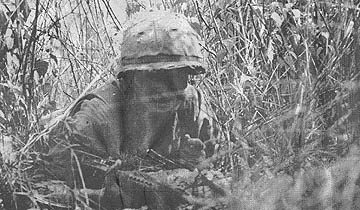 |
COVER - A Tropic Lightning soldier from the 4th Battalion (Mechanized), 23d Infantry Tomahawks crawls through a kill zone in the enemy infested Crescent area. (PHOTO BY SGT ROGER WELT) |
Triple-A Threat Hits Cong; Kills 29, Overruns Bunkers
By SP5 Doug Elliott
CU CHI - Elements from Alpha
Company, 1st Battalion (Mechanized), 5th Infantry and Alpha Company, 2d
Battalion, 14th Infantry, while working with Alpha Company of the 2d Battalion,
34th Armor smote mightily a Viet Cong force in a rubber plantation northwest of
Cu Chi.
By the end of the day, 29
Viet Cong soldiers had lost their lives to the Tropic Lightning troops, and one
enemy became a rallier to the South Vietnamese government through the
Dreadnaughts.
The American forces lost
only one man in the highly successful operation.
The morning found a platoon
from the mechanized and armor units sweeping the thickly wooded area. First signs of enemy activity were discovered by Specialist 4 Herbert
Monroe of Baton Rouge, La., a member of the Dreadnaughts’ Alpha Company, 2d
platoon.
While searching a rice paddy
dike, Monroe found a metal box containing a small Vietnamese booklet with travel
information, pointing out cities and routes and the best means of crossing over
the areas.
Monroe also found a box
containing carbine ammunition and three rocket-propelled grenade boosters.
The mech-armor task force
moved on along the Saigon River banks on the far edge of the area. Swinging back toward Cu Chi, the Dreadnaught-Bobcat team set
up a blocking position for two eagle flights to arrive with units from Alpha
Company, 2d Battalion, 14th Infantry.
By 1:00 pm, the three Alpha
Companies were in contact with a Viet Cong force in a series of bunkers. The initial contact left seven enemy dead in their bunkers and five Viet
Cong attempting to escape.
Pushing deeper into the
area, the 2d Brigade infantrymen and armor drew AK-47 rifle fire again and once
more retaliated on the new enemy positions. Gunships added their firepower and enemy resistance died.
One Viet Cong, seeing the
“Triple A” threat approaching him, decided to rally to the steel giants from
the 2d Battalion, 34th Armor. One
AK-47 was also captured.
Small items were found
throughout the day, such as clothing, a helmet liner, an entrenching tool, saws,
and 300 AK-47 rounds.
The action ended around 5:00
in the afternoon. After Alpha
Company of the Golden Dragons was extracted by choppers, the armor-mechanized
force moved to a new location for the next day’s sweep.
...If It’s The Last Thing We Ever...
Lieutenant Colonel McLean
never misses a chance to use the four-chair Cu Chi Beauty Salon. Neither do several lieutenants, captains and majors.
Of course these officers and gentlemen are ladies and very happy over the
new PX Salon at the 12th Evac Hospital.
Three attendants give
manicures, washes and hair styling service Monday through Saturday, 9 a.m. to 5
p.m., by appointment only. Other
services for the average 28 customers per week include permanents and tints.
The American female
population of Cu Chi is about 70, nurses and Red Cross girls, and the addition
of this back-in-the-world facility is expected to provide a definite morale
boost.
“They do a very nice job. They’re excellent beauticians,” said LTC Mary F. McLean, USAMC, of
the shop’s staff.
| ONSLAUGHT - Dreadnaught armor stalks into enemy positions in search of any North Vietnamese who might remain in an area contested and taken by the 2d Battalion, 34th Armor. (PHOTO BY SP5 DOUG ELLIOTT) |  |
Page 2 TROPIC LIGHTNING NEWS June 9, 1969
Decorated
|
BRONZE STAR (HEROISM) |
|
|
CPT John T. Mader, Co C, 2d Bn, 14th Inf CPT Harry L. Ikner, HHC, 2d Bn, 27th Inf CPT Clarence W. Cornett, Co A, 2d Bn, 27th Inf 1LT Burton J. Tepper, Co C, 125th Sig Bn 1LT Troy E. Ross, Co A, 2d Bn, 12th Inf 1LT Wayne A. Overcast, C Btry, 1st Bn, 8th Arty 1LT Allan L. Reuschel, Co A, 65th Engr Bn 1LT Michael Klages, 25th MP Co, 25th Div 1LT Curtis McFarland, Co B, 3d Bn, 22d Inf 2LT Jose A. Yanez, Co D, 2d Bn, 27th Inf 2LT Paul B. Grigg, Co B, 2d Bn, 22d Inf 2LT William S. Loper, Co B, 1st Bn 27th Inf SFC Robert W. Leathers, Co E, 4th Bn 9th Inf SSG Ronald G. Weers, B Btry, 7th Bn, 11th Fld Arty SSG John R. Abbott, Co C, 1st Bn, 27th Inf SSG Larry J. White, Co C, 1st Bn, 5th Inf SSG Jerrie K. Ramage, Co B, 1st Bn, 27th Inf SSG William J. Lorenz, Co B, 2d Bn, 22d Inf SSG Charles A. Hamilton, Co B, 2d Bn, 22d Inf SSG Victoriano Rivera, Co A, 4th Bn, 23d Inf SSG Lonnie Jackson, Co B, 2d Bn, 22d Inf SSG Erich E. Morris, Co E, 3d Bn, 22d Inf SGT Charles Fleck, Co C, 1st Bn, 27th Inf SGT David G. Miller, B Btry, 7th Bn, 11th Fld Arty SGT Lawrence J. Smith, Co B, 1st Bn, 27th Inf SGT Kerry L. Orr, Co B, 1st Bn, 27th Inf SGT Billy W. Smith, Co A, 1st Bn, 27th Inf SGT Alvin Grimes, Co B, 2d Bn, 22d Inf SGT Johnnie J. Jones, Co B, 2d Bn, 22d Inf SGT Carlis M. Bryant, Co B, 2d Bn, 22d Inf SGT Joseph V. Heltsley, Co D, 2d Bn, 12th Inf SP4 Carl Blackburn, B Btry, 7th Bn, 11th Fld Arty SP4 August P. Gronniger, B Btry, 7th Bn, 11th Fld Arty SP4 Carlos Velozo, Co A, 65th Engr Bn, SP4 Allen W. Ray, B Btry, 7th Bn, 11th Fld Arty SP4 Daniel E. Scott, B Btry, 7th Bn, 11th Fld Arty SP4 Lewis S. Thayer, B Btry, 7th Bn, 11th Fld Arty SP4 Danny Hunter, B Btry, 7th Bn, 11th Arty SP4 David J. Henry, B Btry, 7th Bn, 11th Fld Arty SP4 Rudolph P. Davalos, Co B, 1st Bn, 27th Inf SP4 Robert D. Livingston, Co B, 1st Bn, 27th Inf SP4 Alan J. Hicks, Co B, 1st Bn, 27th Inf |
SP4 Richard D. Herzog, Co B, 1st Bn, 27th Inf SP4 Robert G. Berry, B Btry, 7th Bn, 11th Arty SP4 Quentin R. Fox Jr., B Btry, 7th Bn, 11th Fld Arty SP4 Gerald Anderson, Co B, 1st Bn, 27th Inf SP4 Elisio Valles, Co D, 1st Bn, 5th Inf SP4 Alfred F. Popp, Co A, 2d Bn, 27th Inf SP4 William H. Durden, Co C, 2d Bn, 22d Inf SP4 Brad M. Baker, Co B, 2d Bn, 22d Inf SP4 Thomas E. Harris, Co C, 2d Bn, 22d Inf SP4 Bruce E. Smith, Co C, 2d Bn, 22d Inf SP4 William T. Marlow, Co B, 2d Bn, 22d Inf SP4 Rudolfo, Gutierez, Co C, 1st Bn, 27th Inf SP4 Dewwy L. Owens, HHC, 3d Bn, 22d Inf SP4 Jose T. Zapata, Co C, 1st Bn, 27th Inf SP4 Frederick Jenkins, Co C, 1st Bn, 27th Inf SP4 Stephen Antonishak, Co A, 1st Bn, 5th Inf SP4 George E. Day, Co C, 4th Bn, 9th Inf SP4 William J. Ozanich, Co C, 4th Bn, 9th Inf SP4 Warren Johnson, Co C, 4th Bn, 9th Inf SP4 Carsem D. Tipton, Co B, 1st Bn, 27th Inf SP4 David W. McCormick, Co B, 1st Bn, 27th Inf SP4 Stephen R. Tarragon, Co B, 1st Bn, 27th Inf SP4 Harry J. Miller, Co B, 1st Bn, 27th Inf SP4 Wesley J. Wilber, Co A, 3d Bn, 22d Inf SP4 Larry G. Salares, Co B, 1st Bn, 27th Inf SP4 Ronald E. Olsen, Co B, 1st Bn, 27th Inf PFC Jimmey E. Jewell, B Btry, 7th Bn, 11th Fld Arty PFC Robert L. Barber, Co B, 1st Bn, 27th Inf PFC Varoul Cook, Co A, 1st Bn, 5th Inf PFC Ronald C. Moore, Co A, 1st Bn, 5th Inf PFC Larry A. Saville, Co B, 1st Bn, 27th Inf PFC Kenneth R. Mackey, Co D, 2d Bn, 12th Inf PFC John H. Strange, Co B, 1st Bn, 27th Inf PFC Martin C. Waer, Co B, 1st Bn, 27th Inf PFC Ronald J. Zollner, Co B, 1st Bn, 27th Inf PFC Larry A. Nichlos, Co C, 1st Bn, 27th Inf PFC Kenneth G. Sikes, Co B, 1st Bn, 27th Inf PFC James C. Jackson, Co C, 1st Bn, 27th Inf PFC David D. Mittag, Co C, 4th Bn, 9th Inf PFC Russell J. Dreyer, Co B, 1st Bn, 27th Inf PFC Donnel Delaney, Co B, 1st Bn, 27th Inf |
VC Bombing Attempts Up
Intelligence data now seem
to indicate that the Viet Cong, frustrated in their attempts to storm or
penetrate US bases, are now trying to infiltrate explosive charges onto the
bases.
This tactic has been
attempted previously, with targets where maximum damage can be inflicted like
POL dumps and ammunition storage areas.
Specific methods of
smuggling in such explosives are not known. Methods for preventing the successful use of terrorist bombs include
thorough checks of the labor force coming onto bases and strictly enforced
supervision of groups of indigenous employees during the day.
Additionally, all personnel
must be on the alert for objects and packages suspiciously placed. If you spot one of these items, contact the MPs and the EOD team
immediately.
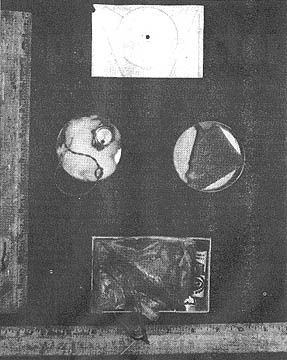 |
TROUBLE – A VC terrorist bomb with its plastic timer was recently picked up by 1st Brigade’s S-2 as the result of several tips. Its small size makes detection difficult. |
| Reminder: You’re invited to listen to the 25th Division’s Radio Show ‘Lightning 25’ every Sunday morning at 11:30 on AFVN, 54 on your radio dial. Army Specialist Jack Schmitt each week spotlights new and exciting talent from the ranks of the Tropic Lightning. Listen this Sunday, you may hear someone you know. |
Interim Health Plan Set
The Department of Defense
has established a special, short-term health insurance program for servicemen
being separated from active duty effective September 1st.
Developed in cooperation
with the health insurance industry, the new, low cost plan is offered during
separation processing and covers its purchasers for the following 90 days.
Servicemen will have a
choice of two plans, one offered by Mutual of Omaha and the other by Blue
Cross-Blue Shield. The Blue Cross-Blue Shield plan will include maternity
benefits.
Total cost of the plan will
be paid by the serviceman. The
amount for 90 days of coverage will range from $16.50 for self only. For comprehensive coverage of self and family, the charge will be $90.
TROPIC LIGHTNING
Combat Honor Roll
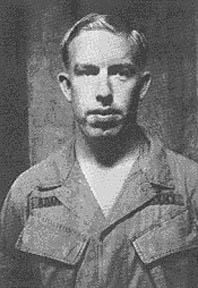 Added to the Tropic
Lightning Combat Honor Roll this week is Specialist 4 Michael Adams, a rifleman
and radio-telephone operator with Company A, 2d Battalion, 12th Infantry
Warriors.
Added to the Tropic
Lightning Combat Honor Roll this week is Specialist 4 Michael Adams, a rifleman
and radio-telephone operator with Company A, 2d Battalion, 12th Infantry
Warriors.
Specialist Adams
distinguished himself by heroic actions on May 1st while his unit was moving
towards its night defensive position. An
enemy force tried to ambush the unit, opening fire on the lead element; which
took several casualties.
Reacting immediately,
Specialist Adams crawled through 35 meters of hostile fire into the kill zone to
aid his comrades. The area was
thickly booby-trapped, but Adams, with complete disregard for his own safety,
continuously re-entered the area amid a barrage of enemy fire to evacuate the
casualties.
Specialist Adams made the
trip six times, each time returning with a wounded man and his equipment. His
valorous actions were responsible for saving several lives.
Specialist Adams’ personal bravery, aggressiveness and
devotion to duty are in keeping with the highest traditions of the Army and
reflect great credit upon himself, his unit, the Division and the Army.
The TROPIC LIGHTNING NEWS is an authorized publication of the 25th Infantry Division. It is published weekly for all division units in the Republic of Vietnam by the Information Office, 25th Infantry Division, APO San Francisco 96225. Army News Features, Army Photo Features, Armed Forces Press Service and Armed Forces News Bureau material are used. Views and opinions expressed are not necessarily those of the Department of the Army. Printed in Tokyo, Japan, by Pacific Stars and Stripes.
MG Ellis W. Williamson . . . . Commanding General
MAJ John C. Fairbank . . . . . Information Officer
1LT John C. Burns . . . . . . . . Officer-in-Charge
SP4 Robert Imler . . . . . . . . . . Editor
SP5 Charles Withrow . . . . . . Assistant Editor
SP4 Ralph Novack . . . . . . . . Production Supervisor
BATTALION CORRESPONDENTS
| SGT
Jan Anderson SP4 Bert Allen SP4 Arthur Brown SP4 Richard Huhta SP4 Karl Karlgaard SP4 Robert Williams |
1/5 1/8 2/12 2/14 2/27 2/27 |
SP5
Doug Elliott SP4 Dave DeMauro PFC Dan Stone SGT Roger Welt SP4 Pete Freeman |
2/34 3/22 4/9 4/23 7/11 |
Page 3 TROPIC LIGHTNING NEWS June 9, 1969
Finds Freedom from Hunger and Fear
Hoi Chanh Is Pleased with His Decision
TAY NINH - Wearing civilian
clothes and an old worn-out pair of sandals, and waving a Chieu Hoi leaflet,
Truong Van Hoanh, 17, cautiously walked into the 688th Regional Forces compound
near Tay Ninh City.
The Regional Forces, who
work in conjunction with the 4th Battalion (Mechanized), 23d Infantry, rushed
out to greet the nervous and excited young soldier who had decided to rally to
the allied side.
Moments after the young Hoi
Chanh walked into the compound, Private First Class James Emerson of Applecreek,
Ohio, adviser to the Vietnamese outpost, radioed the 4/23 commander, Lieutenant
Colonel G.E. Taylor of Shelby, N.C. Taylor
arrived on the scene immediately, followed by an interrogation team.
With everybody
participating, the friendly forces were able to communicate with the scared
young rallier.
Hoanh was forced to become a
Viet Cong several months ago. Until
five days before he rallied he had been an ammo carrier. His last five days as a VC were spent as an official squad
member. He threw away his rifle
before turning himself in.
Constant hunger was his main
reason for giving up.
Young Hoanh was very scared
at first. His squad leader had told
him that Americans kill Hoi Chanhs. “His
nerves calmed down after we told him that no harm would come to him,” said
Taylor. “He was very
co-operative. If there was ever any
doubt in his mind about anything it soon faded. We kept giving him cold soda and iced tea which he thought was great,”
continued Taylor.
Truong Van Hoanh no longer
has to worry about the lack of food, clothing or medicine. Neither does he need to concern himself with the thought of
B-52 raids, artillery and allied firepower. Life means a little more to him; it’s worth living again.
 |
HAVE A LIGHT - First Lieutenant James Mitchell of Theodore, Ala., lights a cigarette for Hoanh as interrogators from the 25th MI Detachment stay in background. (PHOTO BY SGT ROGER WELT) |
| HAVE A SODA - Lieutenant Colonel G. E. Taylor, commanding officer of the 4th Battalion (Mechanized), 23d Infantry, hands Truong Van Hoanh, a Hoi Chanh, a cold soda at Fire Support Base Rawlins, seven miles east of Tay Ninh. (PHOTO BY SGT ROGER WELT) |  |
Chaplains Take Sunday to Fire Bases
CU CHI - To the men of the
25th Infantry Division Artillery, Sunday can be like any other day of the week.
When men work 16 hours or more, seven days a week for almost a year, the
days can seem all the same.
The two DivArty chaplains
help change this. They bring Sunday
to the men.
Major Joseph E. Galle of
Pineville, La., conducts Protestant services and Captain Donato P. Silveri of
Philadelphia, Pa., conducts Catholic services at all DivArty fire support bases
at least once a week. The Chaplains
travel together most of the time.
“Every chaplain in Vietnam
is required to perform a minimum of four services a week. Generally, we conduct from 13 to 20.
We have held up to 22 services in one week,” Galle said.
Easter proved to be a busy
period for the chaplains. Every
fire support base was visited. Silveri
commented, “We have men at fire support bases who don’t have the opportunity
to get into base camp for services. They
have to wait for us to come to them. We
try to get to every fire support base that comes under our responsibility.”
At Fire Support Base
Pershing, Specialist 4 Mario F. Santanna of Bravo Battery, 1st Battalion, 8th
Artillery, says he enjoys talking with the Silveri. “He helps morale,” the Pekin, Ill., native said.
“He goes from gun to gun and talks to the men. When he’s here he talks to every man he can see.
He doesn’t always talk about Vietnam, but about what’s happening back
in the world.”
At Fire Support Base Patton,
Alpha Battery, 3d Battalion, 13th Artillery’s Sergeant Mick Ripley of San
Angelo, Tex., thinks Galle is “more like a civilian. He makes you feel like you’re at the church back home.”
Both chaplains agree morale
is extremely high on the fire support bases they visit. According to Galle, “Men on fire support bases feel like
they are doing a job, and they are. Their
jobs are important and they know it. They
know their commanders and NCOs are concerned, too.”
According to Silveri’s
assistant, Specialist 4 Thomas P. Brady of Yonkers, N.Y., and Galle’s
assistant, Private First Class Dean L. Christensen of Vinton, Iowa, church
attendance has more than doubled since the chaplains arrived at the 25th
Division Artillery’s chapel in Cu Chi. Galle
arrived at Cu Chi four months ago and Silveri six months ago. Silveri was chaplain for four months in Saigon prior to
coming to Cu Chi.
Galle states, “I try to
make the services more active, have more Scripture reading and singing. I try to give them something to think about, for instance, how to handle
their fears, loneliness, worries, doubts, things of this nature.”
The battery commander lets
the chaplains know when the best time is to conduct the service. Fire missions sometimes are called in the middle of a service, and the
men scramble to their guns. After
the fire mission is over, the service is resumed.
| A MOMENT OF PRAYER - Mass is held at Fire Support Base Pershing. Men of Bravo Battery, 1st Battalion, 8th Artillery, pray with Chaplain Donato Silveri. Sometimes a fire mission is called and the men must scramble for their guns. Afterward, the service is resumed. (PHOTO BY SP4 KEN FAIRMAN) |  |
25th Aviation Is Division’s ‘Baby’
The 25th Aviation Battalion
is the “baby” of 25th Division units.
The battalion, whose motto
is “We Fly for the Troops,” was organized in 1957. It earned its first battle streamer in Vietnam.
The youngest of the
division’s infantry and artillery battalions is the 2d Battalion, 34th Armor,
which was organized at Fort Knox, Ky. in 1941. The Dreadnaughts earned two battle streamers during five World War II
campaigns, and was assigned to the Tropic Lightning Division in 1957.
Page 4-5 TROPIC LIGHTNING NEWS June 9, 1969
 |
| SCATTER!!! – Regional Forces from the 165th RF Company scatter as the choppers hit the LZ. Immediately after touching down, the Regional Forces set up a defensive perimeter around the landing zone. |
RFs Move Fast, Hit Hard
Regulars and Regional Forces Assault Together
Story & Photo Feature
by
SP4 David DeMauro
TAY NINH – Fighting an
enemy who chooses to hide within thick jungle and heavy brush necessitates that
the allied forces be aggressive in searching for the “little man.”
For three years the 3d
Battalion, 22nd Infantry, has been conducting extensive air-mobile assaults into
the thickly vegetated terrain of War Zone C southwest of Tay Ninh, seeking out
Charlie and blocking his infiltration route leading from Cambodia to Saigon.
Mobility has been the key to
success in these operations. Highly
maneuverable Huey choppers belonging to the 187th Assault Helicopter Company
have been dropping the Regulars into remote landing zones within the
enemy-infested territory.
Backing up the Regulars as
they hit the ground are lethal Cobra gunships from the Rat Pack gunship section
of the 187th. Should the enemy
decide to show his face, the Cobras are ready to react with grenades, rockets,
and flying lead launched from mini-guns.
Since the first plunge was
made into the triple canopied jungle 5 miles northwest of Saigon, new and better
ways of locating and destroying the enemy have been devised. Recently, well-trained and highly skilled Regional Forces of
the Army of the Republic of South Vietnam have participated in combat assaults.
Men of the 165th Regional
Force Company were trained in their outpost at Cao Xa, a small hamlet four miles
west of Tay Ninh City. Captain John
Malone of Mineral Wells, Tex., the Deputy District Advisor, conducted classes in
the combat assault school. A
chopper was used by the Regional Forces to practice mounting and dismounting.
After plenty of ground practice, the Crusaders ran two “nine-ship
lifts” from Cao Xa to Fire Support Base Washington to give the Vietnamese some
practical experience without the danger of enemy interference.
“The training has been
very effective in building the confidence of the Regional Force soldier in
working away from his outpost,” commented Major James Petty of Fort Worth,
Tex., who is the Senior District Advisor of the Cao Xa compound. Further training will lead the Regional Forces soldier to
even more extensive combat operations away from his outposts. RF participation can truly serve to be valuable in the over-all war
effort.
 |
HEAVY LOAD AND HOT WORK – Beating your way through the jungle is hot and tiring. Specialist 4 Ralph Johnson of Vermillion, Kans., a machine gunner with the Regulars’ Charlie Company, looks forward to riding back to the fire support base at the end of the mission. |
| WALKING isn’t terribly exciting, but it’s a necessary job. Here Sergeant David Strong leads a patrol while he watches for booby traps. Strong is from Houston, Tex., and serves with Charlie Company, 3d Battalion, 22d Infantry. |  |
 |
WAITING FOR THE CALL – After the infantrymen have been dropped at their landing zone the helicopters head back to Tay Ninh base camp where they will wait for the call to pick up the troops. |
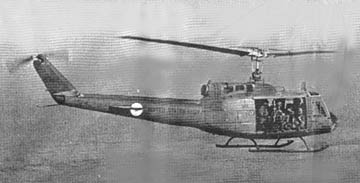 |
FLYING AT 2,500 FEET is cool and troublesome. “The Big Fan” blows plenty of refreshing air through its open doors. This phase of the combat assault is “in” with the jet set. |
| SWITCHING PLACES – The 165th Regional Force Company hits the dirt as the Crusaders lift off from the landing zone. Combined efforts of the Regulars and MACV advisers have aided the Regional Forces on combat assaults after several training sessions. | 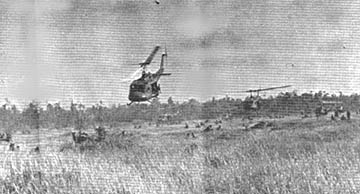 |
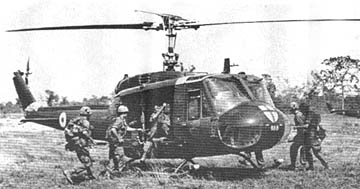 |
CHARGING onto a Crusader chopper as it touches down on the pickup zone are Regular infantrymen. They load on both sides of the helicopter before lifting off. |
| FATHER COBRA of the Rat Pack makes a run above the heads of the Regulars. Protection like this is nice to have around when you’re not on familiar ground. | 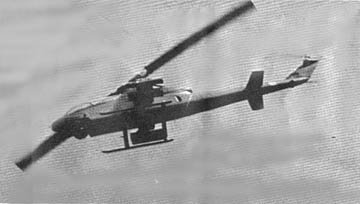 |
Page 6 TROPIC LIGHTNING NEWS June 9, 1969
Wolfhounds’ Modern Horatius
And Platoon Hold That Tiber
By SP5 Jack R. Anderson
DAU TIENG - First Lieutenant
Robert J. Moore is a modern-day Horatius.
But unlike that Roman hero,
who defended the Tiber River bridgeheads with only two companions and a sword,
Moore secures the Dau Tieng bridgehead with a rifle platoon from 1st Battalion,
27th Infantry Wolfhounds plus a host of 20th Century weapons and sophisticated
listening and spotting devices.
The Dau Tieng Bridge,
spanning the Saigon River near the 3d Brigade base camp, has been tagged the
most critical single structure in the brigade’s area of operation. It serves as a communications link between brigade and
division, supporting operations that extend to the Cambodian border.
“Our biggest threat comes
from enemy sappers,” said Moore, a Tampa, Fla., native. “I remember when a captured sapper battalion commander outlined his
battalion’s method for blowing bridges. He
said his men could carry up to a 300 pound satchel charge, underwater, moving
with the current. When they came to
a structure, they simply cut away the charge, and let themselves be carried away
from the explosion by the river current,” Moore said.
To counter the sapper
threat, Moore’s bridge defenders have placed a barbed wire barricade, suspended from wooden planks, into the river on both sides
of the bridge. “A skillful swimmer might be able to get through the wire, but
he’d never be able to drag his charge through. If he tried, he’d make a lot of noise and surface disturbance,” said
Moore.
In addition to the barbed
wire barricade, the defenders blast the surrounding water at irregular intervals
with a quarter pound charge of C-4 explosive.
“If that doesn’t kill a
sapper, it will surely make him think twice about hitting the bridge,” Moore
said.
The world of electronics
plays an important part in the defense of the Dau Tieng bridgehead. Sensitive listening devices and radar are two of the bridge’s front
line defenses.
“My radar people stay out
here full time. They’re trained
well, and, with the experience they receive on the job here, they are definitely
a threat to any enemy who has thoughts of blowing this bridge. Of course, radar can’t stop an enemy, it can only give us
extra eyes and ears - but that’s enough,” Moore said.
The bridge is also
defensively equipped with high intensity lighting, a series of well-fortified
bunkers and other fighting positions, all constructed by Charlie Company, 588th
Engineer Battalion at Dau Tieng.
“About the biggest action
we’ve seen since I’ve been at the bridge has been a two-hour firefight with
some snipers. I really don’t
think they had any intention of taking the bridge,” said Moore. “Every once in awhile, we receive one or two sniper rounds,
but it’s probably just a North Vietnamese or Viet Cong checking out his weapon
after he cleaned it.”
Moore won’t receive all
the land he can plow in a day like his ancient counterpart, Horatius. He’ll just get the satisfaction of doing a tough job well.
 |
LINK - The Dau Tieng Bridge, wood, wire and what-not, straddles the Saigon River near the Tropic Lightning’s 3d Brigade base camp. The bridge is a vital link in the Brigade’s logistical chain that stretches to the Cambodian border. (PHOTO BY SP5 JACK R. ANDERSON) |
Whiskey fifth Readies Roads, Machines for Rainy Day War
By SP4 David C. Mercer
CU CHI - The enemy forces in
the Tropic Lightning area of operations are about to be joined by two of their
most formidable allies - mud and rain. And,
like the enemy, these allies are expected to be beaten. The toll of damages and time lost to mud and rain will be less for Tropic
Lightning this year.
Lieutenant Colonel Edward C.
Gibson, commanding officer of the 65th Engineer Battalion, said, “All of our
direct and general support companies have been engaged almost exclusively during
the past two months preparing fire support base and main supply routes for the
rainy season.”
The preparations include the
digging of ditches in all fire support bases in the division area of operations,
upgrading of roads to include emplacement of culverts, stockpiling of laterite
and culverts, and prepackaging of culverts, bridges and rafts.
New fire support bases, such
as Devins and Emory, are being built close to paved roads. Bunkers are being built above ground and drainage ditches are being dug
around the fire support bases.
Captain Richard Sonstelie of
Alexandria, Va., is the company commander for Delta Company. He has the responsibility for building Fire Support Base Wood III and
improving Mahone II, and maintenance of roads in the Dau Tieng area.
Captain Sonstelie says,
“Our concern is, to the maximum extent possible, to preserve the mobility of
the infantry and mechanized units of the Third Brigade.”
Echo Company has prepared
bridging in advance so that they will be ready to go when and where needed.
There are three H-frames ready for airlift in lengths from 23 feet to 45
feet. The H-frames are bridge
frames stripped as much as possible so that they can be carried by a flying
crane.
A 38-foot dry span bridge is
already loaded on a truck ready for immediate use, as is a five-float reinforced
bridge. In addition to these, the
bridge company has placed four Armored Vehicle Launch Bridges at strategic
locations; Tay Ninh, Dau Tieng, Trang Bang, and Cu Chi, so that they can rapidly
provide bridging capabilities anywhere in the division area.
The AVLB is a 60-foot
folding portable hydraulic dry-span bridge mounted on a tank chassis. Using the powerful hydraulic system it can lay the bridge and pick it up
from either end.
The mud and rain which could
hinder the effectiveness of combat units at fire support bases and on operations
will present little problem this year as a result of the base relocation,
drainage and road work done by the 65th Engineer Battalion.
“Rain has always been a
problem to vehicular travel,” says Lieutenant Colonel Edward C. Gibson. “This is especially true in Vietnam where it rains almost six months a
year, but we think we’re ahead of the problem this year.”
Yes, Rally Once Again
CU CHI - A former Viet Cong
who has been trying to rally to the South Vietnamese government for a year and
four months finally made it to freedom recently. He surrendered to elements of the 2d Battalion, 34th Armor, near Cu Chi.
The new Hoi Chanh (rallier),
nicknamed Charlie by the Dreadnaughts, first tried to rally shortly before the
Tet offensive of 1968. After
completing a re-education course at a Hoi Chanh village, Charlie returned to the
home of his parents for a visit. There
he was recaptured by the Viet Cong.
He was taken to the Hobo
Woods and forced to live in a tunnel for five months. Then came six months of hard labor. He escaped once but was recaptured.
More long months in solitary confinement underground. Finally he slipped away for good when security became lax.
Information Charlie supplied
the Dreadnaughts led to the arrest of four Viet Cong suspects.
Captain James N. Crocker of
Hubert, N.C., commander of the Phu Hoa District Scout Section, explained the
difficulty of remaining a free Hoi Chanh this way: “Many of the Vietnamese
have extremely strong family ties. The
Viet Cong realize this and have only to wait and watch to recapture a Hoi Chanh
when he makes the inevitable return to his village.”
Page 7 TROPIC LIGHTNING NEWS June 9, 1969
Carson Scout Sparks
Victory
By SP4 David DeMauro
TAY NINH – While on an
air-mobile operation 11 and one-half miles west of Tay Ninh City, Delta Company,
3d Battalion, 22d Infantry Regulars killed 17 North Vietnamese rocketeers and
captured numerous weapons and web gear.
Tom Nelson, a Vietnamese
scout who was given the American name by an allied companion, was the first to
make contact with the enemy forces. While
walking point for the company, Tom encountered an NVA soldier who thought the
scout was an NVA and wanted to know what unit Tom was from. Tom asked the NVA if he wanted to Chieu Hoi (rally).
Not knowing what was happening, the NVA took a quick look around and
noticed the Regulars backing up Tom. The
enemy soldier started to run but was cut down by Tom’s M-16.
The lead started flying in
all directions. The Regulars killed
17 NVA.
During the action, Charlie
Company assaulted to assist Delta.
The next morning they moved
into the base camp where the enemy force had been and uncovered three 107mm
rockets as they entered.
“We knew right away that
they had left,” said Captain William Vestal of Glendale, Ariz. “Right away we started finding weapons and munitions and
called for mine sweepers.”
Lieutenant Colonel Robert
Carmichael of Columbus, Ga., battalion commander, was flying overhead in his
command-and-control helicopter and returned immediately to Tay Ninh base camp to
pick up mine sweepers.”
“I knew we needed them to
find the buried munitions,” commented Carmichael. “They definitely paid off.”
All in all, 14 107mm rockets
were uncovered, along with an 82mm mortar tube with bipod legs and base plate,
57 82mm mortar rounds with fuses, one AK-47 assault rifle, and 12 rocket
launchers.
“I was digging in the
bottom of a bunker when I felt something tubular in shape so I called for
assistance,” one regular said. Specialist
4 Ed Sullivan of Charleston, W. Va., came to help scrape away the dirt. The “something tubular” turned out to be an 82mm mortar tube.
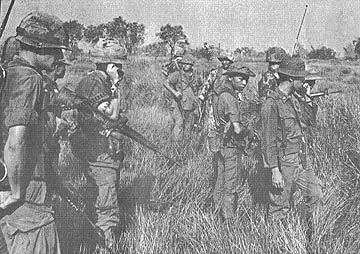 |
WORKING TOGETHER - United States and South Vietnamese Army officers use radios to move their troops on a combined operation near Duc Hue. First Lieutenant Vincent J. Martin Jr., Trenton, N.J. (left), of the 2d Battalion, 27th Infantry Wolfhounds and Lieutenant Mai The Nghia of Duc Hue ‘get on the horn’ as the units maneuver. (PHOTO BY SP4 KARL KARLGAARD) |
Ambush Turned on Cong
By SP5 Jack Anderson
DAU TIENG - Battling Bravo
Company, 1st Battalion, 27th Infantry, fighting their way out of an estimated
platoon-sized ambush, killed eight North Vietnamese soldiers and Viet Cong
troops recently ten miles south of here.
At almost the same time,
Charlie Troop, 3d Squadron, 4th Cavalry, operationally attached to the
Wolfhounds for the day, fought off an estimated company-sized element killing
two enemy soldiers.
When the action occurred,
Bravo Company Wolfhounds were engaged in a sweep operation along the Saigon
River near Dau Tieng with the Cavalrymen working in close support.
One of the biggest
discoveries of the sweep came when the Wolfhounds, again working with the
Cavalrymen, uncovered a tunnel - 10 feet deep and 65 feet long - thought to have
been a hospital.
Inside the tunnel, the
troopers found four CHICOM hand grenades, four SKS rifles, four life
preservers, 12 shot gun shells, 100 pounds of rice, 30 uniforms, and five rifle
grenades. In another tunnel close
by, they found an 82mm mortar intact, 19 rounds of 82mm ammunition and two RPG-7
rounds.
Other action resulted in the
location and destruction of three bangalore torpedoes, 2,000 rounds of .51
caliber machinegun ammunition, 11 CHICOM hand grenades, six rifle grenades, five
Viet Cong gas masks, three RPG-7 rounds, one RPG-2 round, and 1,100 pounds of
rice.
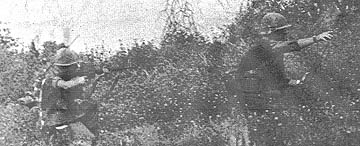 |
ACTION FORWARD - Two 2d Battalion, 12th Infantry Warriors team up to point out enemy positions and lay down cover fire. At the same time other troops are moving up on the enemy line. (PHOTO BY SP4 ART BROWN) |
| THIRSTY WORK - Specialist 4 Courtney Cosgrove of Vanwert, Ohio, tanks up during a break from bunker building at Fire Support Base Emory, three miles from Cu Chi. Cosgrove is a mortarman for Headquarters Company, 2d Battalion, 34th Armor. (PHOTO BY SP5 DOUG ELLIOTT) |  |
Artillery Pounds Enemy Base
By PFC Richard Cunningham
DAU TIENG - The Queen of
Battle found it, and the King of Battle destroyed a major portion of it.
This, in a nutshell, is what
happened to a North Vietnamese bunker complex four miles east of Dau Tieng.
The King, 2d Battalion, 77th
Artillery; 1st Battalion, 27th Artillery; and 2d Battalion, 32d Artillery,
pumped 105mm, 155mm, and eight-inch high explosive projectiles into the bunker
complex. The Queen, 1st Battalion,
27th Infantry, and 2d Battalion (Mechanized), 22d Infantry, discovered the area,
then later found more than 49,000 pounds of rice hidden in nearby caches.
Charlie Battery, 2/77th
Artillery, firing from Fire Support Base Mahone II, began pounding the bunker
area in mid-morning. Later, with
more information from infantrymen in the field, Bravo Battery, 2/77th joined the
fighting along with Alpha Battery, 1/27th Artillery, and Charlie Battery, 2/32d
Artillery.
Early in the afternoon,
artillery fire ceased, allowing the infantrymen to assault the bunkers. Contact was again established and the King was called once more to halt
the enemy.
More than 112 bunkers were
demolished during the battle and artillery support was credited with destroying
much of the enemy stronghold. Artillery
was also credited with killing 20 enemy.
Tomahawks Blast VC Siesta Session
TAY NINH - Taking a siesta
on the side of fabled Nui Ba Den,
55 miles northwest of Saigon, proved fatal to a group of Viet Cong soldiers.
The Viet Cong were rudely interrupted by a reconnaissance element of the
4th Battalion (Mechanized), 23d Infantry, Tomahawks.
Seven of the enemy were
killed as they tried to react to the swiftness of the Tomahawks.
“The Viet Cong weren’t
fast enough. They tried to inflict
damage by pumping out small arms fire, 60mm and 82mm mortar rounds, and
rocket-propelled grenade fire. They
even had a recoilless rifle up there,” said First Lieutenant Patrick J.
Madison of Gary, Ind. “Everything
they used either fell short or went over our heads. We suffered light casualties.”
As the reconnaissance force
exchanged fire with the Viet Cong, Lieutenant Colonel G.E. Taylor of Shelby,
N.C. battalion commander, called in airstrikes on the enemy’s position.
Page 8 TROPIC LIGHTNING NEWS June 9, 1969
41 Chieu Hoi to 3d Bde
DAU TIENG -Forty-one Hoi
Chanhs can’t be wrong.
At least they don’t think
so and neither does the Government of Vietnam, to which they have recently
rallied.
The 41 Hoi Chanhs were all
received by the 3d Brigade at Dau Tieng in two and a half months.
“Our brigade program
doesn’t offer anything special; it’s just an extension of the Vietnamese
government’s program,” said First Lieutenant Keven Walters of Bethpage,
N.Y., the brigade’s psychological operations officer.
THE 3RD BRIGADE Chieu Hoi
program consists of weekly pre-planned leaflet drops plus loudspeaker appeals to
enemy elements in the immediate area. Most
of the appeals, both in leaflet and loudspeaker form, are usually made by Hoi
Chanhs themselves in an attempt to convince their former allies of the benefits
of the Chieu Hoi Program.
“The credibility gap is
the biggest problem we have to bridge,” Walters said. “That’s why we always try to have a Hoi Chanh write the message on a
leaflet and sign it. We also try to include a picture, if possible. Even with our loudspeaker appeals, we try to have a Hoi Chanh
featured on the voice tape,” he said.
But what’s the reason for
the high number of Hoi Chanhs in the brigade’s tactical area of operation?
“It’s a combination of
several things,” Walters said. “First of all, we’ve relocated villagers in
the Michelin Rubber Plantation. We’ve
taken the people out of eight villages and put them into two. This creates a hardship for the Viet Cong soldiers - they
can’t see their loved ones regularly and they have difficulty in obtaining
food and shelter,” he said. “Many
of them turn themselves in just to be reunited with their families.”
ANOTHER REASON for the great
increase in ralliers may be due to the the use of Vietnamese psyops teams,
particularly the one used in the 3rd Brigade area.
“Our team established
rapport with villagers, and through this, we were able to influence the Viet
Cong,” said Walters. “They
would explain the benefits of the Chieu Hoi Program to the families, and the
families would put pressure on Viet Cong soldiers. Sometimes, the team would take Hoi Chanhs back to their villages and let
them tell about the program. This
is another way to bridge the credibility gap.”
Although the Chieu Hoi
Program was developed primarily for the Viet Cong soldier, who is already a
citizen of the Republic of Vietnam, the government still holds out its arms to
the North Vietnamese soldier.
“MOST OF THE NVA Hoi
Chanhs we receive are a direct result of hardships U.S. forces have placed on
them, such as B-52 strikes,” Walters said. “Many times, they give us valuable information which leads to successes
in the field,” he added.
An example of this came
recently when 3rd Brigade units ran into heavy enemy opposition in the
Trapezoid, four miles east of the base camp. An NVA Hoi Chanh gave information
that led to the destruction of more than 250 fortified bunkers, the capture of
some 48,000 pounds of rice and the death of 103 NVA regulars.
THERE ARE SURPRISES in all
aspects of warfare, and psychological warfare is no exception. One of those surprises popped up recently at the brigade’s
psychological operations center.
“We received our first
female Hoi Chanh,” said Walters. “She
worked for the enemy’s psyops team and it was very interesting to compare our
methods with theirs.
“Their methods are similar
to ours, but lack sophistication because of a lack of technology. You can measure the effectiveness of your own program by evaluating the
enemy’s propaganda against it, and, going by that yardstick, our program seems
to be working quite well,” he said.
The Chieu Hoi program
isn’t a one-way street - all Hoi Chanhs are given a fair shake by the
Vietnamese government. They all
receive rewards in proportion to the importance of the intelligence they bring
with them. They can start all over
again, with the choice of learning a trade or aiding the government through
participation on psyops teams or in the Kit Carson Scout program.
‘Flashlight’ Mission Darkens VC Outlook
By SP4 John T. Agnoletti
CU CHI - It was a dark,
moonless night in the jungles of Vietnam. Three
Viet Cong sleeping in a bomb crater were suddenly illuminated by a powerful
light from the sky and killed with a burst of minigun fire.
When Delta Troop, 3d
Squadron, 4th Cavalry, is around, the enemy can’t always rely on the cover of
darkness to provide security.
One of the missions the
airmobile troop performs is referred to as the “flashlight” mission. This consists of night flying with a UH-1D helicopter with a powerful
light attached to the side of the ship. The Centaur pilots, flying low level,
observe the terrain closely in their hunt for the enemy.
On a recent night, Delta
Troop commanding officer Major William R. Laird of Tampa, Fla., and Warrant
Officer John M. Hofman of Palm Beach, Fla., were credited with seven enemy
killed and eight sampans destroyed on a flashlight mission.
Laird and Hofman were flying
in an area where 3d Brigade elements had made contact during the day. The pilots spotted three Viet Cong in a bomb crater and immediately
engaged them with a minigun. All three were killed and eight enemy sampans were found in
the area, destroyed by Centaur firepower.
While flying back to Cu Chi,
Laird was in radio contact with Alpha Troop of the 3/4 Cavalry. Movement had been detected outside Alpha’s night defensive position,
and the flashlight was needed to check the area.
In searching around the
perimeter, Laird spotted five Viet Cong setting up a mortar position. When they opened fire, the ship’s doorgunners claimed four of them.
This was a typical
flashlight for the Delta Troop Centaurs. They
headed back to Cu Chi.
| A MODERN DAY TARZAN - That’s what infantrymen must feel like as they slink through the trees and underbrush that crowd the Saigon River. (PHOTO BY SP5 RICK ADAMS) | 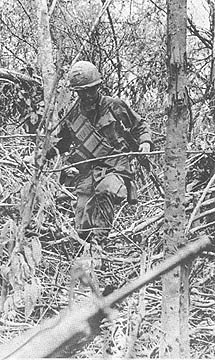 |
Bobcats Zap VC Shipping Engrs
CU CHI - The job of the 65th
Engineer Battalion is hard enough without enemy interference. So when the engineers working near the Trang Bang Bridge
received RPG and small arms’ fire, elements of Bravo and Charlie companies of
the 1st Battalion (Mechanized), 5th Infantry, rolled into the area.
The Bobcats, along with
tanks from the 2d Battalion, 34th Armor, dispersed their forces to cover a wide
area.
As the force entered a
thickly vegetated zone, tank-mounted 90mm guns, 50 caliber machineguns and a
bevy of small arms’ fire assured the armored line a safe passage once they
entered the patch of jungle.
The tactics worked. Five enemy were killed, and there were several blood trails in the area.
| DANGER: the ice used in beverages sold by local Vietnamese causes infectious hepatitis in one out of every 15 US soldiers who drink such beverages. This disease attacks the liver, often with fatal results and always with lasting damage to health. |
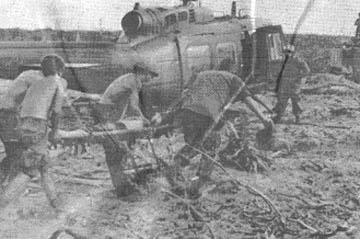 |
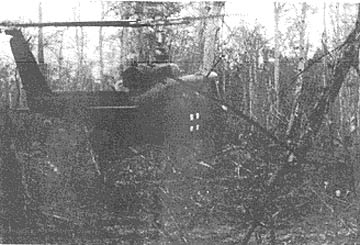 |
 |
| NO TIME TO WASTE - in the top picture, an armored personnel carrier secures a dustoff ship as soldiers rush a wounded buddy to the world’s fastest ambulance service. Sometimes jungle terrain is too dense for choppers to land. Often dustoff ships get close enough (as in center pic) for a wounded soldier to climb aboard. The bottom shot shows a dustoff rising from the jungle floor and streaking toward waiting doctors from Bravo Company, 25th Medical Battalion at Dau Tieng. (PHOTOS BY SP5 RICK ADAMS) |
Thanks to
Mack D. Gooding, 15th PID, 1st Bde., for sharing this issue,
Kirk Ramsey, 2nd Bn., 14th Inf. for creating this page.
This page last modified 8-12-2004
©2004 25th Infantry Division Association. All rights reserved.